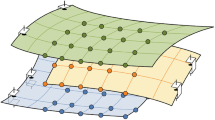Abstract
Flexible Assembly Systems (FASs), which form an important subset of modern manufacturing systems, are finding increasing use in today's industry. In the planning and design phase of these systems, it is useful to have tools that predict system performance for various operating conditions. In this article, we present such a performance analysis tool based on queueing approximation for a class of FASs, namely, closed-loop flexible assembly systems (CL-FASs). For CL-FASs, we describe iterative algorithms for computing steady-state performance measures, including production rate and station utilizations. These algorithms are computationally simple and have a fast convergence rate. We derive a new approximation to correct the mean delay at each queue. This improves the accuracy of performance prediction, especially in the case of small CL-FASs. Comparisons with simulation results indicate that the approximation technique is reasonably accurate for a broad range of parameter values and system sizes. This makes possible efficient (fast and computationally inexpensive) analysis of CL-FASs under various conditions.
Similar content being viewed by others
References
Agrawal, S. C.,Metamodeling: A Study of Approximations in Queueing Models, MIT Press, Cambridge, Mass. (1985).
Ammons, J. C., Lofgren, C. B. and McGinnis, L. F., “A Large-Scale Machine-Loading Problem in Flexible Assembly”, inFlexible Manufacturing Systems: Operations Research Models and Applications, K. E. Stecke and R. Suri (eds.) J. C. Baltzer, Basel, Switzerland (1985) pp. 319–332.
Boothroyd, G., Poli, C. and Murch, L. E.,Automatic Assembly Systems. Marcel Dekker, New York (1982).
Buzacott, J. A. and J. G. Shanthikumar, “Models for Understanding Flexible Manufacturing Systems”,AIEE Transactions 12, pp. 339–350 (1980).
. “On Approximate Queueing Models of Dynamic Job Shops”,Management Science 31, pp. 870–887 (1985).
Buzacott, J. A. and Yao, D. D., “Flexible Manufacturing Systems: A Review of Analytical Models”,Management Science 32, pp. 890–905 (1986).
Buzen, J. P., “Computational Algorithms for Closed Queueing Networks with Exponential Servers”,Communications of the ACM 16, pp. 527–531 (1973).
Gordon, W. J. and Newell, G. F., “Cyclic Queueing Systems with Restricted-Length Queues”,Operations Research 15, pp. 266–277 (1967).
Groover, M. P., Weiss, M., Nagel, R. N. and Odrey, N. G.,Industrial Robotics: Technology, Programming, and Applications, McGraw-Hill, New York (1986).
Kamath, M. and J. L. Sanders, “Analysis of Asynchronous Automatic Assembly Systems with Bottleneck Stations”,SYSTEMS I Conference Papers, SME, Chicago, ILL. (1986a).
. 1986b. RENA: “A New Approach to the Analysis of Asynchronous Automatic Assembly Systems”, Technical Report 85-6. Department of Industrial Engineering, University of Wisconsin-Madison, Madison, WI 53706.
Kobayashi, H., “Application of the Diffusion Approximation to Queueing Networks”, I. Equilibrium Queue Distributions.Journal of the ACM 21, pp. 316–328 (1974).
Koenigsberg, E., “Twenty-Five Years of Cyclic Queues and Closed Queue Networks: A Review”,Journal of the Operational Research Society 33, pp. 605–619 (1982).
Koenigsberg, E. and Mamer, A., “The Analysis of Production Systems”,International Journal of Production Research 20, pp. 1–14 (1982).
Kuehn, P. J., “Approximate Analysis of General Queueing Networks by Decomposition”,IEEE Transactions on Communications COM-27, pp. 113–126 (1979).
Liu, C. M. and Sanders, J. L. “Stochastic Design Optimization of Asynchronous Flexible Assembly Systems”, inProceedings of the Second ORSA/TIMS Conference on Flexible Manufacturing Systems (Ann Arbor, Mich.), K. E. Stecke and R. Suri, (eds.) Elsevier, Amsterdam, The Netherlands, pp. 191–202. (1986).
Marshall, K. T., “Some Inequalities in Queueing”,Operations Research 16, pp. 651–665 (1968).
Reiser, M. and Kobayashi, H. “Accuracy of the Diffusion Approximation for Some Queueing Systems”,IBM Journal of Research and Development 18, pp. 110–124 (1974).
Reiser, M. and S. S. Lavenberg, “Mean-Value Analysis of Closed Multichain Queueing Network”,Journal of the ACM 27, pp. 313–332 (1980).
Shanthikumar, J. G., and J. A. Buzacott, “On the Approximations to the Single Server Queue”,International Journal of Production Research 18, pp. 761–773 (1980).
Shanthikumar, J. G. and M. Gocmen, “Heuristic Analysis of Closed Queueing Networks”,International Journal of Production Research 21, pp. 675–690 (1983).
Shum, A. W. and J. P. Buzen, “The EPF Technique: A Method for Obtaining Approximate Solutions to Closed Queueing Networks with General Service Times”, inProceedings of the Third International Symposium on Measuring, Modelling, and Evaluating Computer Systems, Bonn, FRG pp. 201–220 (1977).
Solberg, J. J., “A Mathematical Model of Computerized Manufacturing Systems”, inProceedings of the Fourth International Conference on Production Research (Tokyo) (1977).
Suri, R. and G. W. Diehl, “A Variable Buffer-Size Model and Its Use in Analyzing Closed Queueing Networks with Blocking”,Management Science 32, pp. 206–224 (1986).
. 1987. Rought-Cut Modeling: An Alternative to Simulation.CIM Review 3 (Winter): 25–32.
Suri, R., Diehl, G. W. and R. Dean, “Quick and Easy Manufacturing Systems Analysis Using MANUPLAN”, inProceedings of the Spring IIE Conference (Institute of Industrial Engineers) (Dallas, Tex.), 195–205 (1986).
Suri, R. and R. R. Hildebrant, “Modelling Flexible Manufacturing Systems Using Mean-Value Analysis”,Journal of Manufacturing Systems 3, pp. 27–38 (1984).
Whitt, W., “The Queueing Network Analyzer”.Bell Systems Technical Journal 62, pp. 2779–2815 (1983).
, “Approximations to Departure Processes and Queues in Series”,Naval Research Logistics Quarterly 31, pp. 499–521 (1984a).
, “Open and Closed Networks of Queues”,AT&T Bell Laboratories Technical Journal 63, pp. 1911–1979 (1984b).
, “The Best Order of Queues in Series”,Management Science 31, pp. 475–487 (1985).
Yao, D. D. and J. A. Buzacott, “Modelling the Performance of Manufacturing Systems”,International Journal of Production Research 23, pp. 945–959 (1985a).
, “Queueing Models for a Flexible Machining Station. I. The Diffusion Approximation”,European Journal of Operational Research 19, pp. 233–240 (1985b).
, “Models of Flexible Manufacturing Systems with Limited Local Buffers”,International Journal of Production Research 24, pp. 107–118 (1986).
Author information
Authors and Affiliations
Rights and permissions
About this article
Cite this article
Kamath, M., Suri, R. & Sanders, J.L. Analytical performance models for closed-loop flexible assembly systems. Int J Flex Manuf Syst 1, 51–84 (1988). https://doi.org/10.1007/BF00713159
Issue Date:
DOI: https://doi.org/10.1007/BF00713159




